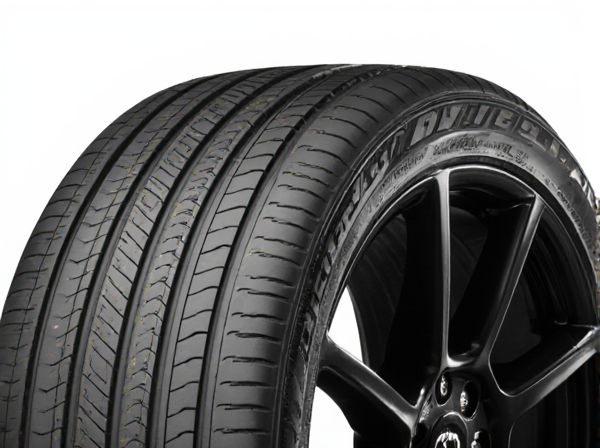
Photo illustration: Performance Tire vs Touring Tire
Performance tires offer enhanced grip and handling suited for spirited driving and high-speed maneuvering, making them ideal for sports cars or aggressive driving styles. Touring tires focus on providing a smooth, comfortable ride with longer tread life and better fuel efficiency, perfect for everyday commuting and long-distance travel. Your choice depends on whether you prioritize dynamic driving performance or comfort and durability in various road conditions.
Table of Comparison
| Feature | Performance Tire | Touring Tire |
|---|---|---|
| Purpose | Enhanced grip and handling at high speeds | Comfortable, smooth ride with long tread life |
| Tread Design | Asymmetric or directional for maximum traction | Symmetric with optimized patterns for longevity |
| Rubber Compound | Softer for better grip but faster wear | Harder for increased durability and fuel efficiency |
| Ride Comfort | Stiffer sidewalls, less comfort | Softer sidewalls, enhanced comfort |
| Wet and Dry Performance | Superior traction in wet and dry conditions | Reliable but moderate traction overall |
| Noise Level | Generally louder during driving | Quieter and smoother on highways |
| Typical Tread Life | 30,000 to 50,000 miles | 50,000 to 70,000 miles |
| Ideal For | Sports cars, aggressive driving | Sedans, daily commuting, long trips |
Introduction to Performance and Touring Tires
Performance tires are engineered for enhanced handling, superior traction, and responsiveness, making them ideal for sports cars and aggressive driving conditions. Touring tires provide a balanced combination of comfort, longevity, and fuel efficiency, tailored for everyday driving and long-distance travel. These tire types differ primarily in their tread patterns, rubber compounds, and construction to meet specific driving preferences and vehicle requirements.
Key Differences Between Performance and Touring Tires
Performance tires prioritize enhanced grip, handling, and responsiveness by using softer rubber compounds and sportier tread patterns, ideal for aggressive driving and high-speed cornering. Touring tires emphasize comfort, durability, and quieter rides with harder compounds, deeper tread depths, and optimized patterns designed for long-distance driving and even wear. Key differences lie in tread design, rubber composition, and intended use, with performance tires sacrificing tread life and noise for superior traction, while touring tires balance comfort, longevity, and fuel efficiency.
Tread Design: Performance vs Touring
Performance tires feature aggressive tread patterns with larger shoulder blocks and fewer grooves to enhance grip and cornering at high speeds, optimizing traction on dry and wet roads. Touring tires have more intricate tread designs with multiple sipes and circumferential grooves to improve water evacuation and provide a quieter, smoother ride. The tread compound in performance tires prioritizes responsiveness, while touring tire tread focuses on longevity and comfort during extended driving.
Handling and Traction Comparison
Performance tires deliver superior handling with enhanced cornering stability and quicker response due to their softer rubber compounds and aggressive tread patterns, making them ideal for sporty driving. Touring tires prioritize traction in a variety of conditions, including wet and dry surfaces, providing a smoother ride and longer tread life with optimized all-season rubber formulas. The performance tire excels on dry roads with maximum grip, while touring tires balance traction and comfort for everyday driving scenarios.
Ride Comfort and Noise Levels
Performance tires typically feature stiffer sidewalls and sportier tread patterns designed for enhanced handling and responsiveness, which can result in a firmer ride and increased road noise. Touring tires prioritize ride comfort with softer sidewalls and optimized tread designs, significantly reducing noise levels and absorbing road imperfections for a smoother driving experience. Noise reduction technologies and rubber compounds used in touring tires contribute to quieter cabins compared to performance tires.
Tire Longevity and Durability
Performance tires typically offer enhanced grip and handling but have a shorter tread life, averaging around 20,000 to 40,000 miles due to softer rubber compounds designed for better traction. Touring tires emphasize tire longevity and durability, often lasting between 50,000 to 80,000 miles, thanks to harder rubber compounds and reinforced sidewalls that resist wear and damage. Drivers seeking extended tire lifespan and consistent performance in various driving conditions generally prefer touring tires over performance tires.
Seasonal Suitability: Which Tire Fits Your Climate?
Performance tires excel in warm, dry conditions with specialized rubber compounds that enhance grip and handling but often harden and lose traction in cold or snowy climates. Touring tires feature all-season designs with tread patterns and silica-based compounds that maintain flexibility and provide reliable traction in mild winter weather, including light snow. Choosing the right tire depends on regional climate patterns: performance tires suit temperate to hot environments, while touring tires are ideal for areas with variable seasons and occasional winter conditions.
Fuel Efficiency Considerations
Performance tires typically have softer rubber compounds and more aggressive tread patterns, which can increase rolling resistance and reduce fuel efficiency compared to touring tires. Touring tires are designed with harder compounds and optimized tread designs that minimize rolling resistance, enhancing fuel economy during everyday driving. Choosing touring tires can lead to measurable fuel savings, especially over long distances or in city driving conditions.
Cost Analysis: Performance vs Touring Tires
Performance tires typically have higher upfront costs due to advanced materials and specialized tread designs, leading to enhanced grip and handling. Touring tires, while generally more affordable initially, offer longer tread life and improved fuel efficiency, reducing overall expenses over time. Evaluating cost per mile, touring tires often provide better value for daily commuting, whereas performance tires may incur higher costs from faster wear and more frequent replacements.
Choosing the Right Tire for Your Driving Needs
Performance tires offer superior grip, handling, and responsiveness, making them ideal for spirited driving and high-speed maneuvers. Touring tires prioritize comfort, longevity, and a quiet ride, suited for everyday commuting and long-distance trips. Selecting the right tire depends on your driving style, vehicle type, and preference for either enhanced performance or durability and comfort.
 caratoz.com
caratoz.com